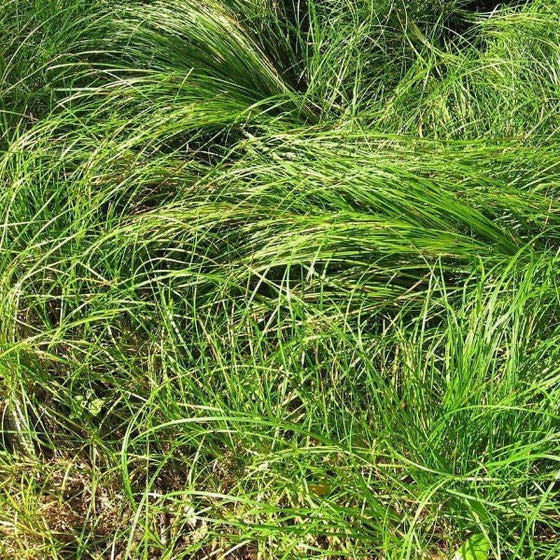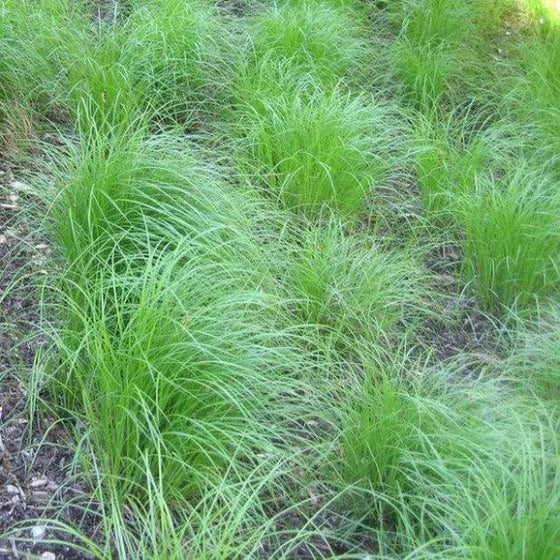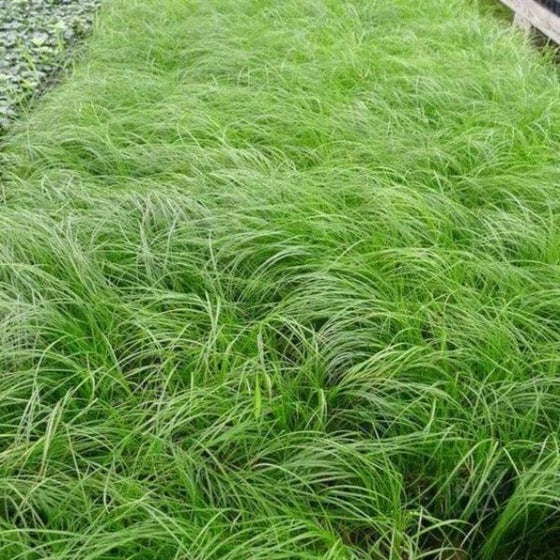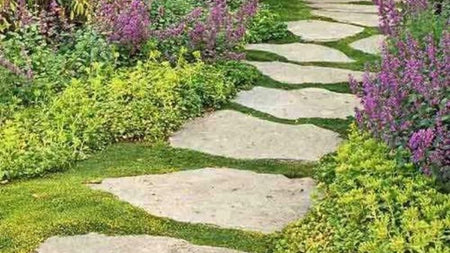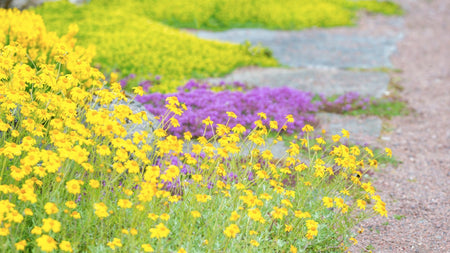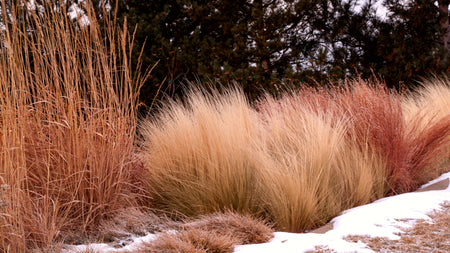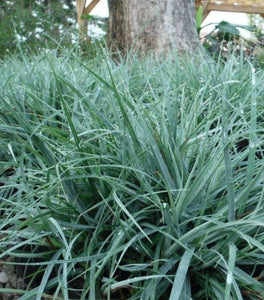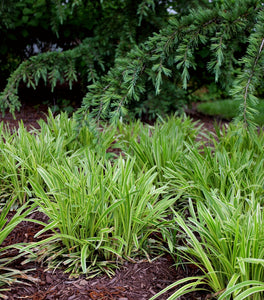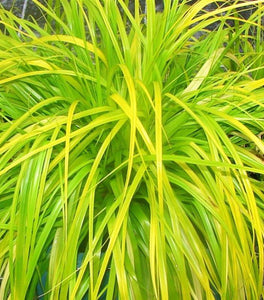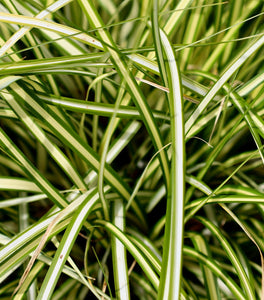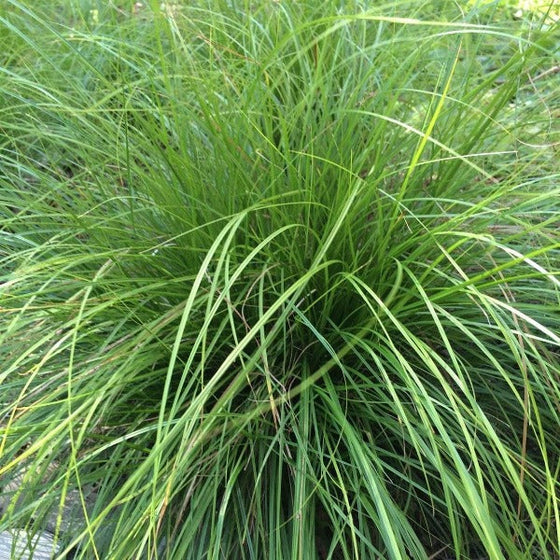
Images Depict Mature Plants
Pennsylvania Sedge Plants for Sale Online
Pennsylvania Sedge (Carex pensylvanica) is a versatile and low-maintenance ornamental grass known for its fine, arching green foliage that creates a soft, meadow-like appearance. This native sedge thrives in shaded areas, making it an excellent choice for ground cover in woodland gardens, shaded borders, and naturalized landscapes. Its delicate, grass-like texture adds a lush, flowing element to the garden, offering year-round interest with its semi-evergreen nature. Unlike many traditional grasses, Pennsylvania Sedge tolerates both dry and moist soils, making it an adaptable option for a variety of growing conditions.
Hardy in USDA Zones 3-8, Pennsylvania Sedge is a cold-hardy species that can withstand a wide range of climates. It typically grows to about 6-12 inches tall and spreads up to 12-18 inches wide, forming dense clumps that are ideal for erosion control and filling in shaded areas where turfgrass struggles. This sedge is perfect for creating a natural lawn alternative in shaded areas, requiring minimal mowing and thriving with little water once established. Pennsylvania Sedge is particularly suited for use in areas under trees, where its ability to tolerate dry shade and root competition makes it a standout performer.
In addition to its beauty and practicality, Carex pensylvanica is also deer-resistant, further enhancing its value in naturalized and low-maintenance landscapes. Its ability to thrive in dappled sunlight or deep shade makes it an ideal companion for other shade-loving perennials like ferns, hostas, and wildflowers. Whether used as a lawn alternative, ground cover, or an accent in mixed plantings, Pennsylvania Sedge brings texture, ecological benefits, and low-maintenance beauty to any garden or landscape design.
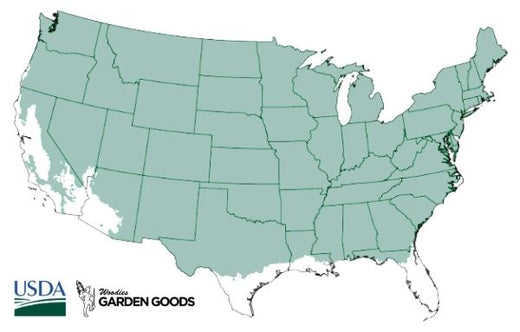
| Hardiness Zone: | 3-8 |
|---|---|
| Mature Height: | 6 to 12 Inches |
| Mature Width: | 12 to 18 Inches |
| Sunlight: | Part sun to part shade |
| Water Requirements: | Moist to average |
How to Care for Pennsylvania Sedge
Be sure to read our planting instructions to ensure a healthy and happy Pennsylvania Sedge for years to come!
How do I plant Pennsylvania Sedge Plants?
To plant Pennsylvania Sedge (Carex pensylvanica), begin by selecting a site that offers partial to full shade, as this native sedge thrives in low-light conditions. Ensure the soil is well-draining, as Pennsylvania Sedge prefers moist soils but can tolerate dry conditions once established. Start by loosening the soil to a depth of about 4-6 inches, which will help the roots establish quickly. Dig a hole slightly wider than the root ball of your sedge plant, place the plant in the hole, and make sure the top of the root ball is level with the surrounding soil. Gently backfill the hole, firming the soil around the base of the plant to eliminate any air pockets. After planting, water the Pennsylvania Sedge thoroughly to help the roots settle. For the first few weeks, keep the soil consistently moist to encourage strong root establishment. If you're planting multiple sedge plants to cover a lawn area or as ground cover, space them about 8-12 inches apart for a dense, lush look. This sedge is ideal for shaded garden beds, woodland areas, or as a natural lawn alternative under trees. Once established, Pennsylvania Sedge requires minimal maintenance and can tolerate periods of drought, making it a low-maintenance option for sustainable, eco-friendly landscaping.
How do I Water Pennsylvania Sedge Plants?
To water Pennsylvania Sedge (Carex pensylvanica) properly, focus on providing consistent moisture during the plant's establishment period. After planting, water the sedge thoroughly to help the roots settle and begin to establish in the soil. For the first few weeks, keep the soil consistently moist but not waterlogged, watering deeply once or twice a week, depending on rainfall and temperature. Deep watering encourages the roots to grow downward, helping the plant become more drought-tolerant over time. If the weather is particularly hot or dry, you may need to water more frequently to prevent the soil from drying out completely. Once Pennsylvania Sedge is established, it becomes quite drought-tolerant and requires much less frequent watering. In normal conditions, you can reduce watering to occasional deep waterings, especially during extended dry spells. This sedge prefers moist but well-drained soil, so it's important not to let it sit in standing water or overly saturated conditions for long periods. Mulching around the plants can help retain moisture and reduce the frequency of watering. With proper watering, Pennsylvania Sedge will thrive, providing lush, low-maintenance ground cover that enhances shaded landscapes or naturalized garden areas.
How do I Fertilize Pennsylvania Sedge Plants?
Fertilizing Pennsylvania Sedge (Carex pensylvanica) is a straightforward process that enhances its lush growth while maintaining its low-maintenance appeal. Since this native sedge thrives in moderately fertile soils, it typically doesn’t require heavy feeding. However, to give it a boost, you can apply a balanced, slow-release fertilizer, such as a 10-10-10 formula, in early spring when new growth begins. Spread the fertilizer evenly around the base of the plant, being careful not to let it come into direct contact with the foliage. Water thoroughly after applying the fertilizer to help the nutrients reach the roots. Organic compost or a top-dressing of composted manure can also be used as an alternative, enriching the soil naturally over time. Once established, Pennsylvania Sedge usually requires minimal additional fertilization. In poor or depleted soils, you can apply a light layer of compost or a low-nitrogen fertilizer in mid-summer to keep the plants healthy and vibrant. Avoid over-fertilizing, as excessive nutrients can lead to overly lush growth, which may reduce the plant’s drought tolerance. By providing just the right amount of nutrients, Pennsylvania Sedge will continue to thrive, offering a beautiful, natural ground cover that enhances shaded areas, woodland gardens, or eco-friendly lawns.

How Do I Prune Pennsylvania Sedge?
Pruning Pennsylvania Sedge (Carex pensylvanica) is a simple task that helps maintain its neat appearance and promotes healthy growth. The best time to prune this sedge is in late winter or early spring, just before new growth begins. Use sharp garden shears to trim back any dead or damaged foliage to about 2-3 inches above the ground. This will help clear away old growth, allowing fresh, green blades to emerge for the upcoming growing season. Regularly removing dead or browning leaves will keep your Pennsylvania Sedge looking tidy and vibrant throughout the year. During the growing season, Pennsylvania Sedge typically requires minimal pruning, as its clumping habit helps it maintain a naturally attractive form. If any blades become damaged or start to brown due to environmental factors, you can trim those selectively to maintain a clean look. Since this sedge is low-maintenance, excessive pruning is unnecessary, but periodic trimming can enhance its appearance, especially if used as a ground cover or natural lawn alternative. By following a light pruning routine, Pennsylvania Sedge will continue to thrive and add texture, greenery, and natural beauty to your shaded garden spaces.

